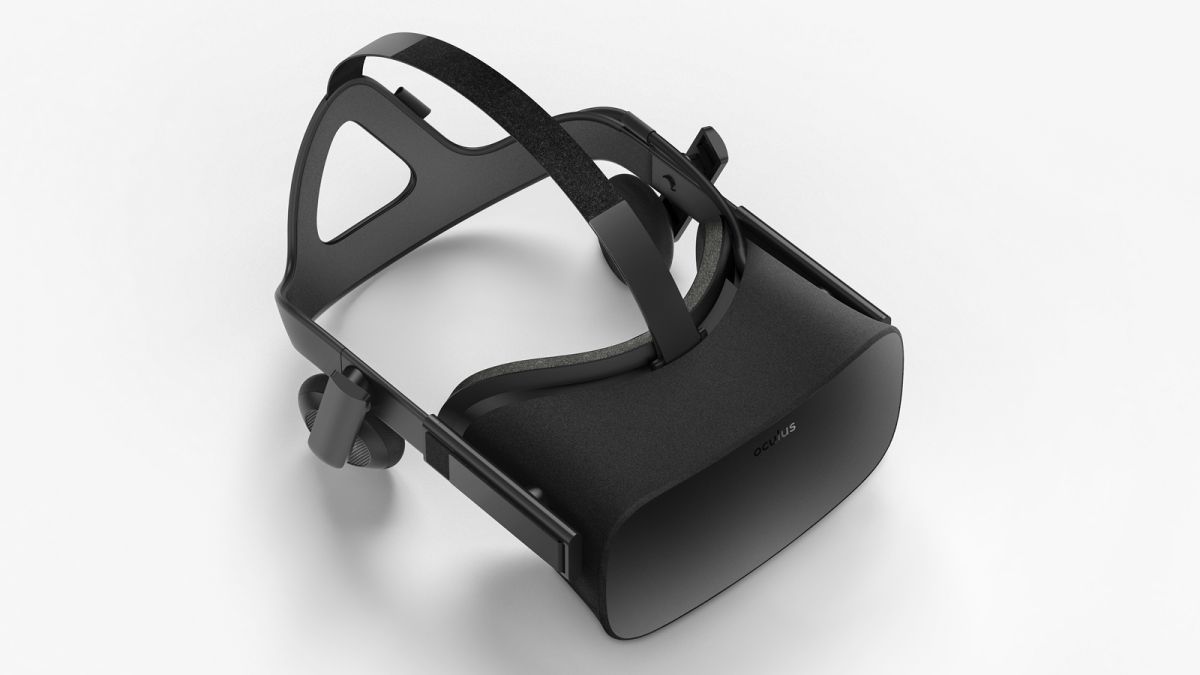
What it’s like to wear Oculus Rift
Update: The first consumer-ready Oculus Rift headsets have shipped and are on the way to consumers. In fact, Oculus founder Palmer Luckey already hand-delivered the first Rift to a customer in Alaska. Everyone else should expect to see headsets arriving on doorsteps beginning Monday, March 28. However, that date is only for headsets that were pre-ordered several months ago. You can still pre-order a Rift, it just won’t get to you by March 28.
When I think of virtual reality, I think of immersive experiences that transport me to places, real or make believe, I would otherwise never see. VR is the stuff of sci-fi: mesmerizing, otherworldly, and maybe just a little unsettling. It’s going from Point A to who knows where or when, without leaving wherever your mortal shell is in the here and now.
Oculus Rift has achieved this effect, and it’s done so in what feels like the blink of an eye. I can say from my own experience of first trying Rift at GDC 2014 all the way to using the final version just two weeks ago, it’s come a long, long way in a relatively short amount of time. And now, it’s finally on its way to consumers.
Rif’ts transformation begins in the hardware itself. Compared to that first early prototype and later dev kits, the consumer Rift feels like it actually belongs on your face. It’s lightweight, comfortable and refined.

This extends to the software. Rift’s launch games are precisely, often beautifully, rendered. The latency and pixelation issues of earlier Rifts are a distant memory. The games are smooth and stable, and each is delightful in its own way. Whereas at that GDC two years ago the experiences were short, laggy, yet still promising demos, Rift’s 30 launch titles are, for the most part, fully realized games.
Oculus has placed a premium on great content for Rift, developed both internally and externally, as Oculus founder Palmer Luckey explained to me.
There’s no argument the games are gorgeous … if you’re using Oculus Rift on an optimized PC. Therein lies the rub: if you’re not, how do games like ADR1FT, an intense launch title set in space, run? I asked Oculus just that question, but haven’t heard back yet. I can imagine, however, that it’s not going to be a good time for anyone.
If your PC is up to spec – which will cost at least $1,000 (about £707, AU$1,331) if you buy one bundled with the $599/£499/AU$649 headset – then Oculus Rift opens up worlds that are unlike anything you’ve ever seen or experienced. The best part? It’s all only going to get better.
What it’s like to wear Oculus Rift
The Oculus Rift headset is an elegant, sleek and, dare I say, stylish black brick you stick on your face. You may not look great wearing it, but the actual hardware can’t be faulted for aesthetics.
It’s a far cry from the rough, borderline janky construction of the very first prototype we tried only a few years ago.

Oculus Rift consumer edition isn’t weighty: it almost has a hollow feel, though once you have it on it definitely feels like you have something more substantial than a baseball cap over your head and eyes.
The visor portion doesn’t dig in thanks to dense foam and, when it’s tightened just right, it fits snuggly. Foam cushions the back portion of the strap, so your head is cradled in the Rift.
It’s a little tricky, however, to get the headset to fit just right. When it’s too loose, gaps allow light to come through from underneath the faceplate. Personally, it was kind of a relief to have some connection to the outside world when I looked down and could see a sliver of my hands holding the Xbox One controller, though some may find it distracting.
Rift also needs to be positioned properly on your face, otherwise the focus in the VR experience is off. This will happen if the headset is hanging a little loose or isn’t centered, creating a blurred effect. Too tight, and while the headset is secure and the focus generally spot on, it tends to be uncomfortable. When this happened, it never got to the point where I needed to take the headset off to escape the discomfort, but it ached slightly, like I was wearing a hat a few sizes too small.
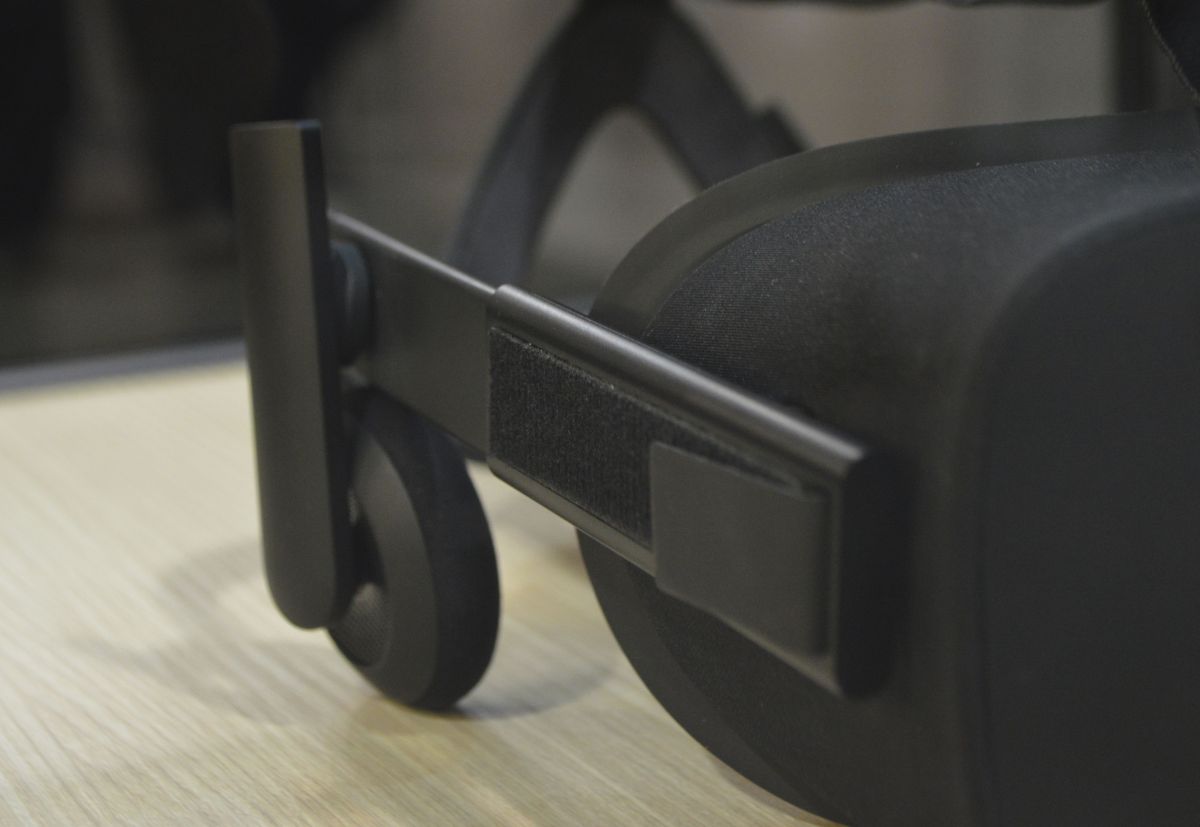
The headphones are as unobtrusive as they come. They’re positioned flush on the headset, and you can easily flip them over to hear the outside world. When they are turned toward your ear canal, they pump in crisp audio that adds to the immersion.
With the headphones turned in, it almost feels like you’re wearing a lightweight helmet rather than a visor, and it helps draw you even further into the virtual world before your eyes.
The sound offered by the built-in headphones gave me a sense of presence in the Rift’s VR experiences, and I think they’d suite most average users. However, while it’s convenient that the headphones are included, you can also remove the audio arms to use your own set if you prefer a more premium sound.
One gripe with the audio is that it can be so enveloping, especially if the volume is turned up, that you’re cut off from the world around you. I had to strain to hear what people who were sitting no more than two feet away from me were saying if the volume was on the higher end. Unlike Microsoft HoloLens, which lets you not only see everything that’s in your environment but also hear fairly well, you don’t always have that ability with Oculus Rift.

It could become troublesome if someone comes into a room and tries to talk to you, but you can’t see or hear them. Maybe completely uninterrupted alone time what you want, but it might be harder for some to justify tuning out the world completely.
I’ll dive into the Oculus Touch controllers a little later in this review, but the Xbox One controller that comes with every Rift feels like a bit of an add-on. “Here, we didn’t make this, but you need it to play!” Still, there weren’t any hardware issues. It’s a perfectly capable controller, so no complaints there.
The final standout piece of the hardware is the PC tether, the headset’s lifeline to the engine that runs all of its experiences. It comes out the rear of the headset and curves over your back or shoulder, and it’s a light touch that you don’t really feel unless your arm gets hooked under it, which happened to me. You’ll also definitely notice it if you’re sitting on it, start to tilt your head forward and suddenly find you can’t move it any further, like reaching the end of a rope.
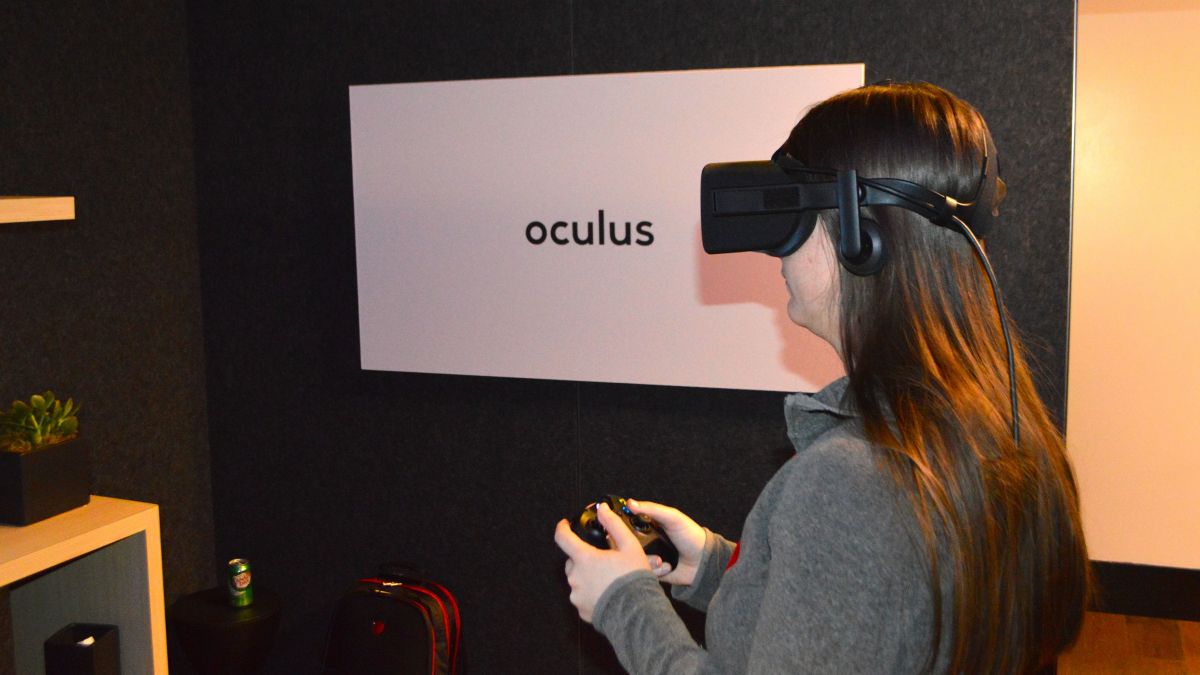
I played a Rift game standing, and while I could sense the tether’s presence, it didn’t get in the way (and I didn’t fall over it – yay!). One of this particular game’s producers told me that the team designed it for a PC and accounted for the tether, so it in a way influenced the game, or at least how the devs thought about helping players avoid it.
Oculus Touch controllers
Oculus Touch controllers
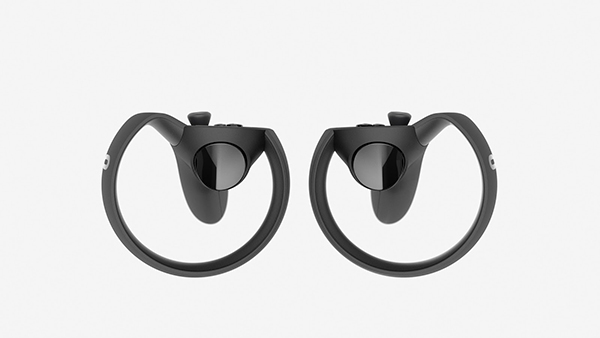
Oculus Touch won’t be available for Rift at launch as Oculus wanted more time to perfect the controllers. The company plans to release them in the second half of 2016, at which time it will also launch a number of games that will take advantage of hand tracking.
The company told me it’s improved the controllers in a number of areas, and I was able to test a recently refined version of Touch a few weeks ago.
This was my first time using Oculus’ proprietary peripheral for Rift, incorporating at long last my hands into a virtual reality experience.
I used Touch to play a game called VR Sports Challenge, and while I was gripping the controllers with my real hands, what I saw in the game was a computer-generated pair of hands. While these mitts weren’t mine, when I saw them, it felt right. There wasn’t that, “Wait, where did my hands go?!” moment, which can happen – even on a subconscious level – when you’re using the Xbox One controller and you look down with the headset on.
The hands in VR Sports Challenge were male and only went to partway up the wrist or forearm before fading into the scenery, but it didn’t bother me to have these disembodied stranger’s hands acting as my own. I was too enraptured with their ability to shoot a basketball and take snaps before attempting a touchdown pass to care.
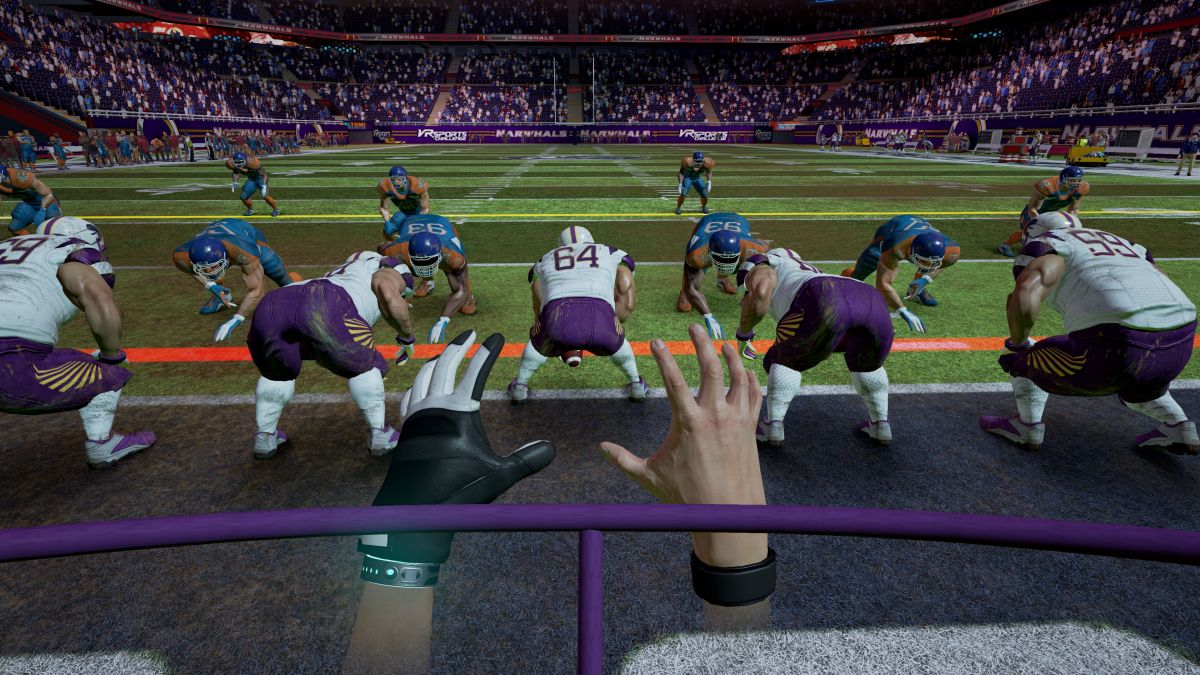
Haptic feedback gives you the sensation that you’re grabbing and holding onto the ball, and “letting go” of it when you release the trigger button. It’s a subtle effect that almost tricks you into thinking you’re playing with tangible objects.
While I found the controllers to be as well designed as Rift, it might be better if they were a little heavier so they feel more substantial in your real-life hands. I can see why the controllers have that same hollow feel as the headset, though: Oculus doesn’t want you to get tired while you’re playing. Still, when I went to chuck a football or flicked my wrist to shoot a basketball, it felt like I was putting in more effort than the controllers warranted. It didn’t feel completely satisfying.
A thin black rope loops Touch to your wrist, like Wii remote controllers. Someone assisted me in slipping the loop on, so it’s likely you’ll need a helper at home, have to put them on yourself before the headset, or generally know where they are once you have the Rift covering your eyes.
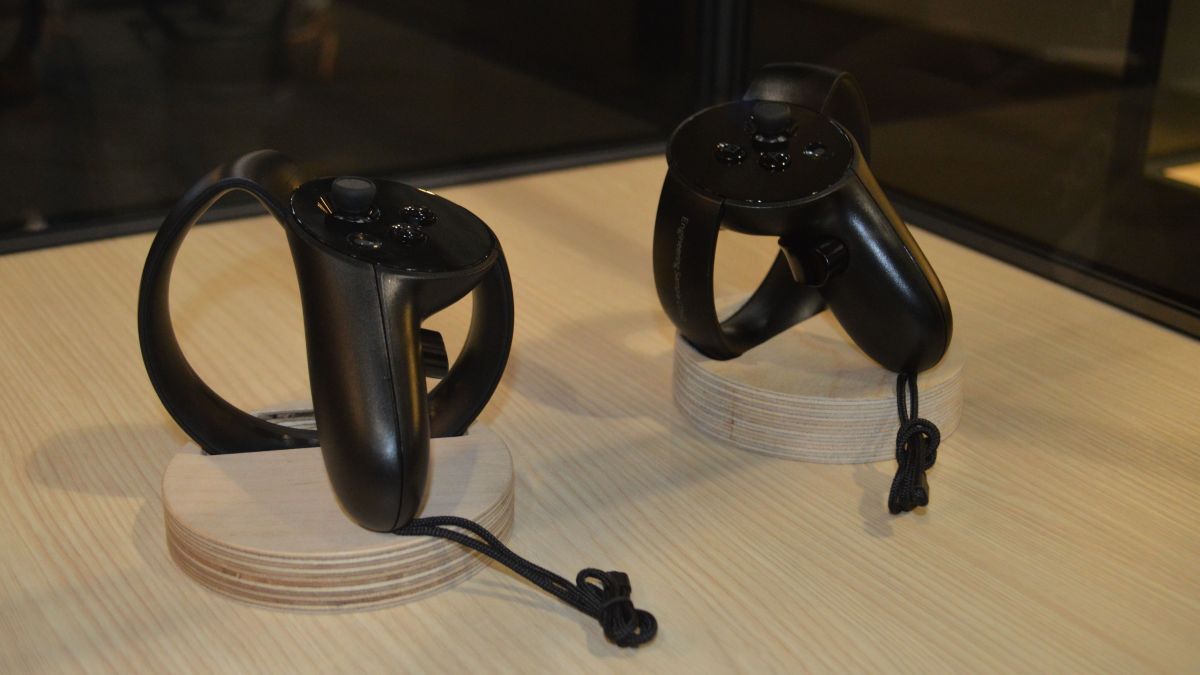
With the Touch controllers, I dominated a 3-point shooting contest, failed miserably at being a football quarterback (I’m a much better virtual wide receiver, it turns out), and soared in a slam dunk contest. While I wasn’t making holding and releasing motions with my hands in the real world, the controllers executed their commands proficiently.
The controllers were polished, but they felt like they have one too many buttons and knobs, and some of the command options weren’t intuitive. In the slam dunk contest, for example, I was supposed to be able to switch the basketball between my hands by letting go of the trigger in one hand and pushing down the other.
It was a lot harder than it sounds when you’re also trying to focus on what’s going on in the game and releasing the basketball at just the right moment by also letting go of the triggers to put it in the basket. It felt like perhaps the A button should have let me release the basketball while the triggers let me do tricks.
Maybe that’s a kink for VR Sports Challenge to work out, or something Oculus needs to consider when it comes to how developers are able to implement controls.

Having the use of your hands in VR makes a substantial difference in how immersive the experience feels, though for the right games: I didn’t feel the need to have my hands in most of the other launch titles I tried.
ADR1FT and RPG Damaged Core both come to mind as titles where it would have been awesome to reach out and grab life-saving oxygen tanks with my hands, or position them like I was holding a rifle.
ADR1FT Creative Director Adam Orth of Three One Zero told me it was too late to add Touch support to the game, but said the team is already working on incorporating it in another title.
The limits of Touch
The ability to move my arms to execute in-game motions and seeing visible-if-unrealistic hands in the game turned me into an active participant in a VR world for the first time ever.
As opposed to sitting in a chair with a controller in my lap, I was now standing, throwing and shooting using my whole body on the virtual court and gridiron. Even though I didn’t need to, I was squaring up as if I was actually going to shoot a basketball and dropping back to pass the virtual football.

In real life, I was holding onto nothing except the Touch, but the controllers allowed more of my body to participate in VR. It’s incredible the difference that makes.
What’s frustrating, however, is that I wasn’t using genuine hand and finger motions to perform the actions the game required. Even though I could see a pair of hands holding the basketball or football in front of me as if I had just picked them up and was about to hurl them towards their targets, all I was really doing was pressing some buttons.
To throw a football to someone in the real world, my body instinctively takes over. My fingers know just how to flick, my wrist knows how to turn, and my hand knows how to position itself for accuracy.
It didn’t quite compute, then, when I had to parse those motions down to the restrictions of a controller that only needs me to press a few buttons to execute the throw. I still had to make a throwing motion with my arm, yes, but it was that final act of “letting go” that left me wanting more.
Maybe with more play time I would learn the nuances of the game and it would all run more smoothly and I wouldn’t care about pressing buttons, but as-is Touch provides greater immersion – up to a certain point.
Oculus Rift games and Early verdict
Oculus Rift games
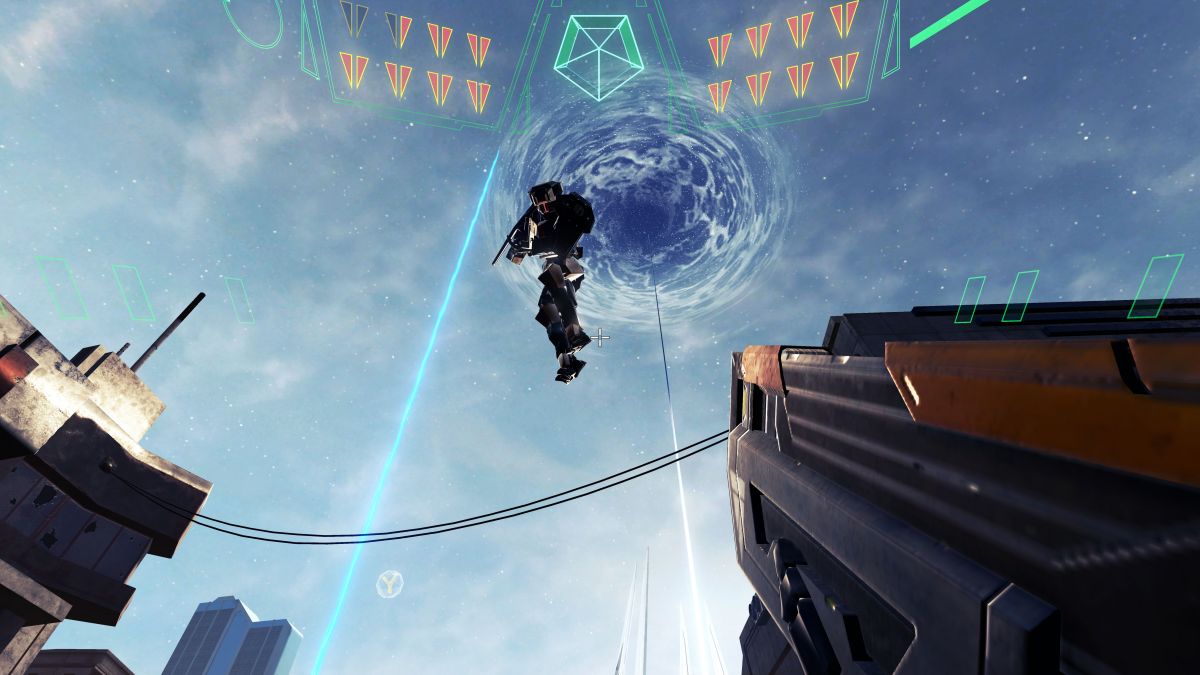
According to Oculus, there will be roughly 30 games available on Day One, with more to follow soon after. The Oculus Touch launch later this year will herald the release of even more games.
The launch titles span the spectrum, from the innocuous, like VR Tennis Online, to the extreme, like ADR1FT. Oculus Rift game prices range from free-to-play to $49.99 (about £35.37, AU$66.57), and everything in between.
I played a half a dozen or so launch titles on the consumer-ready Rift, and was blown away by their quality. I was only able to play each for half-hour chunks at a time, so it’s hard to say how well they’ll age over the course of several hours, days, weeks and months, but the taste I had of almost all of them left me wanting more.
All succeeded in transporting me to another place thanks to their attention to detail (is that really rain water pooling at my feet?), smooth rendering and flushed-out narratives. I particularly enjoyed the games where I was standing, like Damaged Core, which allowed me to pivot around and engage more of my body in the action.
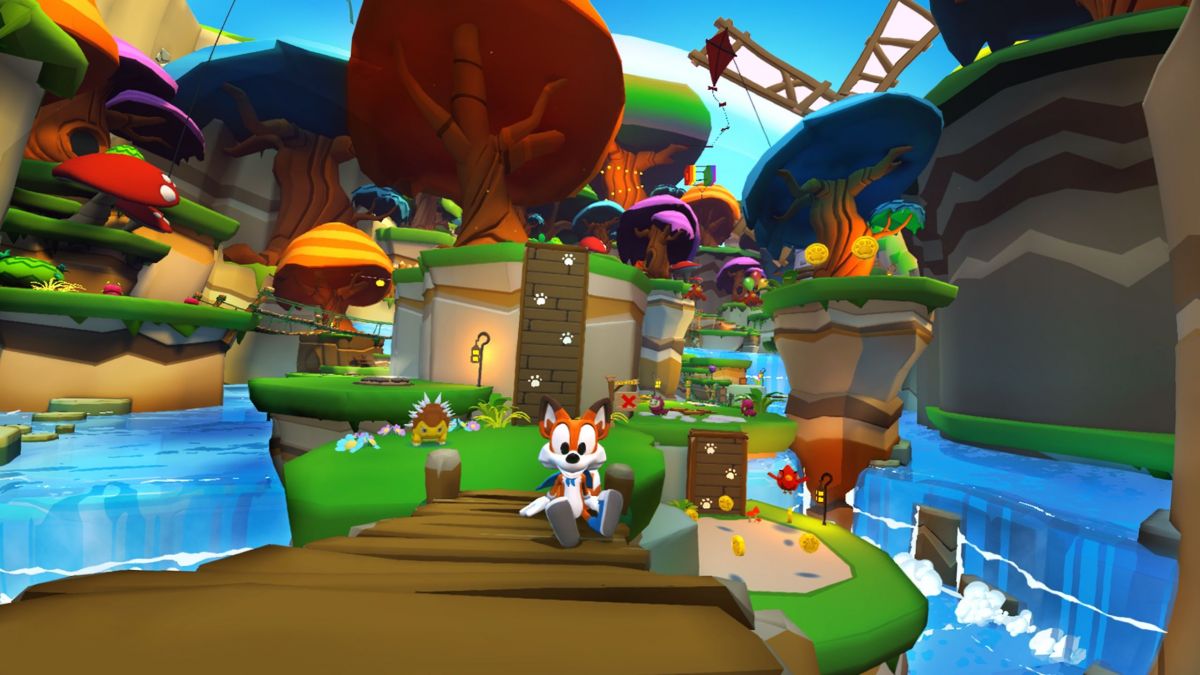
Each title offered a completely different experience, and Oculus Head of Studios Jason Rubin told me the company wanted to provide a wide range of launch titles to have something for everyone.
Many of the titles are standard gaming fare, though there’s nothing standard about the sense of presence and immediacy they induce. Others, though, offer one-of-a-kind experiences that you can’t have on any other platform.
The Climb, for example, has you rock climbing with Touch controllers. ADR1FT nearly has you believing you’re running out of oxygen on a wrecked space ship. Even Fly to KUMA, an innocent game involving teddy bears, lets you rotate around 3D block puzzles as if you were an omniscient being.
Oculus Rift’s launch games are rated Comfortable, Moderate or Intense, a helpful guide for users to know what they’re getting into before they strap on the headset.
Early verdict
Experiencing the evolution of Oculus Rift has been almost awe-inspiring. Oculus has stuck to its vision, even when those early prototypes were questionable and the demos nearly too laggy to bear. I can’t help but feel like I’ve not only witnessed the next transformative phase of computing, but also been a small part of it because I tried the Rift at several stages along the way.
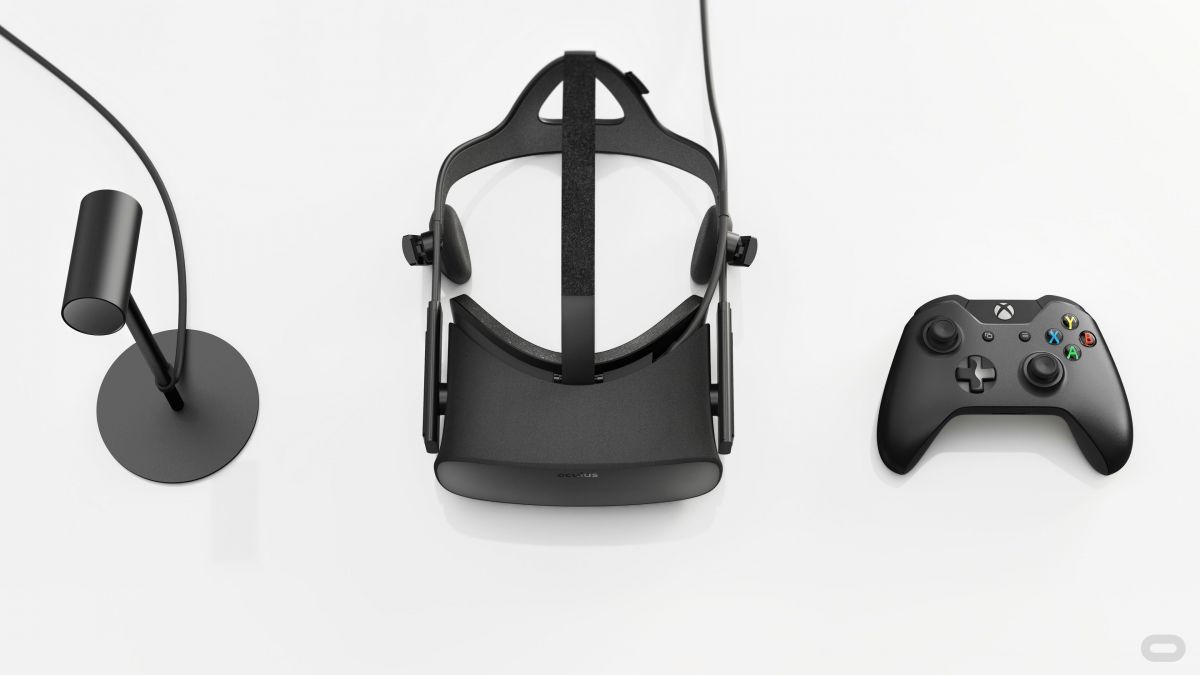
The consumer-ready Rift is a lovely piece of hardware. But it’s more than just a pretty headset: Oculus has built a whole ecosystem for its baby, from the sound of the built-in headphones to the games to the Touch controllers.
As soon as you put on the Rift, you are transported to a whole new world. Touch controllers, though limited in some ways, will bring the rest of your body along for the ride.
The problem, of course, is everything that’s not the Rift, its controllers or games. While $600 is a hefty chunk of change for any device, it’s the PC set-up that, on the low-end, is over one-and-a-half times more expensive than the headset that consumers will get stuck on.
The price of the whole package is going to be prohibitive, and it’s likely going to keep many from jumping to Rift right away. But for those who have a compatible PC or invest in one and take the Rift plunge, it’s going to be worth every penny.
When Touch controllers come out and Rift, one day, loses the tether and a few dollars, it will transform how we play games, do work and interact with one another. If Rift has come this far, this fast, I don’t think it’s going to be much longer before that comes true, too.
Source: techradar.com










































My main question is, what about the screen door effect? In my current device, The Samsung GearVR, the magnification is to the extent to where you can see the pixels of the phone marring the immersive effect of VR to an extent. I have not been able to sample the Rift as of yet so I was wary of Pre ordering something so expensive without having any idea of the quality of the display. I will be waiting to sample one hands on before I buy it to see if it lives up to the hype.
I read elsewhere on TechRadar one of the testers was reviewing some of the games and mentioned he had his glasses on through out
Just use the term VR no need for anything else to be added.
I do have access to Morpheus…. And I have a DK2… They are just pieces of hardware, it's the ecosystem around them that will define success.
I'm a little confused as to why HTC Vive isn't mentioned amongst the competition. Am I missing something?
Key point to note here is that you don't have a developer morpheus so you haven't had access to any PS4 VR games at all so complaining about the poor quality of DK2 games is very unfair. You are aware that DK2 is a developer kit for developers? Yes non-developers buy it but it is intended for developers. I have tried a number of 3rd party demos and the experience is exactly what I would expect… incredible immersion… life-size 3d visuals. DCS flight sim has oculus support built in. Of course there are amateurish demos and games but that is also one of the advantages the Oculus has… OPEN DEVELOPMENT for everyone…. The PS4 install base will only be a percentage of PS4 users depending on cost of morpheus and quality of the experience. Problem is the morpheus is crippled by Sony's control. I remember pre-PS3 sales hype with Sony saying the PS3 was a super-computer and it could be used for more than just games. The reality was that when sony saw the PS3 being used for applications other than games they locked it down even more.
$1500 includes PC+HMD cost. Oculus recommended PCs start at $900, not $1500. Please stop spreading misinformation.
Exactly right. Sony did exactly that with the PS3… When people were installing linux on the PS3… sony put a stop to it. PS3 used for scientific applications? Sony put a stop to it. PS4 is a games console and a locked-down one. If that's all someone wants then that's their choice. It's not for me though. I want open development, I want there to be all kinds of demos and games both professional and amateur. Sony wouldn't even have a morpheus had it not been for Palmer making Oculus a reality. Prior to Oculus Sony had a VR device little better than those we saw in the 90's and it has been priced at $1500. It took Palmer to shake things up.
Exactly right. People don't have to max out game settings and not all games require super graphics cards (Portal 2 runs on very old GPU's). What we will see now are a range of new more affordable micro PC's to compete with consoles. PC's always won out in terms of performance but they lost in terms of desktop space and cost. That should start to change now.
I wonder if they thought about people with eye impairments when building this. Can anyone confirm this for me?
Alot of bla bla in this article and no interesting information for a tech enthusiast. Waste of time.
I think the BIG advantages for the Morpheus is the massive PS4 install base and that the games are designed and optimised for the hardware to get 120Hz going, as a DK2 owner, the amount of bloaty juddery messes out there is enough to put some people off when they try it. However, if you have a 980ti SLI setup, the Rift, or even Valve's headset will no doubt offer better graphical immersion.
I really can't see how Morpheus will be able to run any decent or recent games, given the struggle that the PS4 already has with 1080p resolutions and high frame rates. It's pointless attempting to run anything at anything beyond 30fps given that there will be additional overheads for the hardware regardless of whether it can support 120hz updates…..the games simply won't be able to update fast enough….and that's a big problem when the lens are right in front of your eyeball!
gamingvisor is cheaper…
They should also sell a minimal, barebone version.
The earphones, custom dac, controllers, external sensors – all add a lot to the cost and increase manufacturing costs aswell.
It would likely drop 30-40% in cost if you skip those.
But i guess someone "sponsoring" wants their crap being sold.
Gamingvisor is for pc and console. Players will be totally immersed in games with the advantage of not having to wait for development of 3D games.
Time will tell, the PS4 install base is huge. Want a decent experience on the rift? 980ti? $1400 setup all in, easy. It will remain niche on the PC, the PC has always been niche, not necessarily a bad thing. Mass market will be closed systems, always has been, always will be.
Have you seen their financials?
I found that not bothering with VR means I don't have to take extra pills.
All thx to gaming 😀 its really a dream come true
BS. Games and fun are forever. All girls eventually turn into fat men.
Too much resolution needed for this at the moment, will happen eventually.
So basically, VIVE is better for Comfort, controls, features and has an onboard audio jack for your own headphones (as well as all the other benefits of Vive).
Vive it is then!
Mine craft is not a simplistic game. Do you mean games with low detail graphics? I could see it working with complex games its just that the graphics with need to be at PS2/3 levels in order for the high framerates required by VR.
If it works and is more than a novelty then it possibly means the end of the XBOX One as a serious gaming machine.
I hope that doesn't mean we'll just get loads of simplistic novelty games a la Mincraft:/